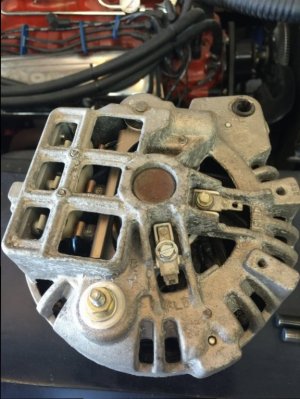Nacho-RT74
Well-Known Member
Tipically the grounded brush on one field alternators is the other one, so JUST TO MATCH the earlier assemblies, would ground the other one... Is just about somekind of correctness, not really about if it will work or not. You can ground either one as mentioned.
Of course funknut is showing the other one because he is parting an alt which is already a single field one which it gets just one brush isolated
And no, both prongs are the same size than the existant female terminals on our harnesses ( packards 56 ). HOWEVER, laters alts ( 80s ) usually known as 78 or 80 amps changed the prongs for a tab with a hole to get terminals attached with screws. These are easy to change, using earlier brushes on same mounting assembly
Need to note, from late 70s ( when alt housing changed for a more sealed one ) also changed one of the isolation shape. Brush can be the same but isolator not. If I find a pic will post.
This is just for the records and extra info
Of course funknut is showing the other one because he is parting an alt which is already a single field one which it gets just one brush isolated
And no, both prongs are the same size than the existant female terminals on our harnesses ( packards 56 ). HOWEVER, laters alts ( 80s ) usually known as 78 or 80 amps changed the prongs for a tab with a hole to get terminals attached with screws. These are easy to change, using earlier brushes on same mounting assembly
Need to note, from late 70s ( when alt housing changed for a more sealed one ) also changed one of the isolation shape. Brush can be the same but isolator not. If I find a pic will post.
This is just for the records and extra info
Last edited:

















